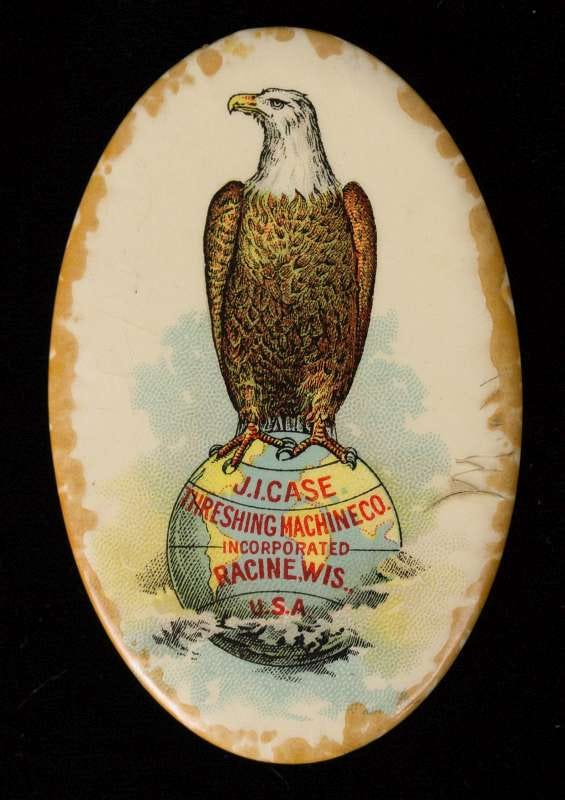In 1865 Old Abe began a career as the most famous bird in agricultural history as the trademark of the J. I. Case Company.
As seen in the picture above, the company trademark was an American Bald Eagle perched atop a globe.
For over 100 years the Case Eagle made its mark wherever men obtained their living from the soil. The Eagle trademark identified Case machinery parts, literature, branch houses, and dealers. The Old Abe logo appeared in advertisements for the company, as well as on the sides of many of its machines and as hood ornaments. Cast iron statues of the logo were placed at Case facilities around the world.
During World War II Case had a campaign in which they asked their dealers to turn in the cast iron Eagles for scrap metal thus making these original statues quite rare today.
The Case eagle was inspired by a bald eagle who was the mascot for a Union company in the American Civil War and named after President Abraham Lincoln. Old Abe first sat atop a globe in 1894, whereas before she had perched on a branch. The first logo pictured a likeness of Old Abe on a branch with the words, “J.I. Case Threshing Machine Co.” and the company’s home, Racine, Wisconsin, printed on the branch itself. Years later, conveying a more global approach, the company decided to portray the likeness on top of a globe with the same words on the face of the globe.
In 1969, the J. I. Case Company introduced a new series of agricultural tractors christened the "Agri-King" line. At the same time, after 104 years, the 'Old Abe' eagle emblem and trademark were retired and replaced by a new corporate symbol.
The J.I. Case Threshing Machine Company’s branch office in Calgary, Alberta was located at 10th Avenue and 4th Street SW from 1911 until 1970. Below is a hand-tinted photograph from the Glenbow Archives of the Case building, taken around the time it first opened. As you can see, Old Abe stands proudly overlooking the scene.
The original '“Old Abe” wasn’t fashioned out of metal, nor was she a corporate mascot. Instead, Abe the 1st was a live bald eagle who ended up in the hands of a Union army captain in Wisconsin during the American Civil War. Old Abe’s owner named the bird after President Abraham Lincoln even though she was a female eagle. Apparently, Old Abe was a highly valued member of the Eighth Regiment of the Wisconsin Volunteer Infantry, and was even the target of enemy soldiers who desired to kill or capture the bird.
She participated in over thirty battles, narrowly avoiding significant wounds on several occasions. During the war, she became a rallying point to Union troops and an anathema to Confederate soldiers, who called her the ‘Yankee Buzzard’ and set bounties on her. Her service to the Union resulted in widespread fame, and her life after the war reflected the esteem with which Wisconsin and other states held her. While fire ultimately took Old Abe’s life and physical remains, her legacy still remains and can be seen to this day around Wisconsin and the United States. Besides serving as the Case logo she is also the screaming eagle that adorns the insignia of the U.S. Army’s 101st Airborne Division.
Old Abe perished in an 1881 fire in Madison, Wis. The bird was 20 years old.















